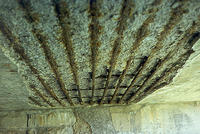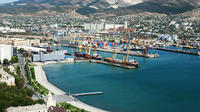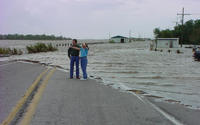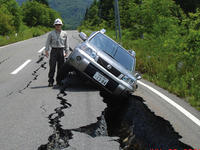-
Era of major volcanic eruptions nears

The recent volcanic eruptions in Iceland upset airline bosses and caused a lot of fuss, but they were trivial by comparison with what could happen next, according to Clive Oppenheimer’s new book; 10 percent of the world’s population and at least twelve major cities now located within range of a volcano, so a more accurate perspective is needed on what they can do, so that rational plans can be drawn up in preparation for future events
-
-
Sector Report for Monday, 13 June 2011: Infrastructure protection
This report contains the following stories.
-
-
Larry Summers calls for $100 billion in infrastructure spending
A former chief White House economic advisor is urging lawmakers to approve $100 billion in additional infrastructure spending to help boost the economy and prevent stagnation; Larry Summers, the former director of the White House National Economic Council for President Obama, wrote that it would be “premature” to limit fiscal support for the economy at the end of 2011
-
-
Montana floods cause $8.6 million in damage to infrastructure
Towns in Montana have been hit particularly hard by floods, causing an estimated $8.6 million in damage to public infrastructure; officials expect that figure to increase in the coming weeks as flooding will continue for some time
-
-
New concrete could increase life of bridges by forty years

Researchers have developed a new type of concrete that could increase the lifespan of bridges by more than forty years compared to normal strength concrete; the more durable type of concrete minimizes shrinkage, a problem typically found in high-strength concrete; the new concrete is also less likely to crack, which reduces the ability for corrosive materials like chlorides from de-icing salts to seep into the bridge’s internal structure; the new concrete uses a lightweight porous type of sand
-
-
Climate change and cities: a wake-up call

More than half the world’s population live in cities, many of which are increasingly vulnerable to the impacts of climate change; cities, however, are also emerging as the innovative “first responders” in dealing with climate change; climate change will stress cities in many ways — there will be more heat waves, threatening the health of the elderly and infirm; droughts will also become more commonplace in many cities, while in coastal communities too much water may be the problem, due to sea-level rise and more extreme coastal flooding
-
-
QinetiQ's OptaSense to protect India's major oil pipeline

The 670 km Mangala Development Pipeline (MDP) is the world’s longest continuously heated and insulated pipeline; it will have access to 75 percent of India’s refining capacity; the company operating it will install QinetiQ’s OptaSense technology to secure the pipeline; OptaSense system is designed to detect, classify, and locate potential threats to buried pipelines
-
-
Ports unprepared for increase in Katrina-like storms

A recent report by Stanford University researchers found that the majority of seaports around the world are unprepared for rising sea levels and increasingly violent storms; a majority of ports surveyed listed sea level rise and increasing extreme storms as some of their top concerns; only 6 percent of respondents said they have plans to build hurricane barriers in the next ten years, and less than 18 percent said they had plans to build dikes or other storm protection structures; to ease uncertainty among port authorities, researchers developed a computer model to provide cost estimates that take into account a port’s specific location as well as the cost of labor, materials, and equipment for fortifying a structure against rising sea levels
-
-
Digital ants protect critical infrastructure
As the U.S. electrical power grid becomes more interconnected through the Internet, the chances of cyber attacks increase as well; a Wake Forest University security expert developed “digital ants” to protect critical networks; unlike traditional security approaches, which are static, digital ants wander through computer networks looking for threats such as computer worms, self-replicating programs designed to steal information or facilitate unauthorized use of computers; when a digital ant detects a threat, it summons an army of ants to converge at that location, drawing the attention of human operators to investigate
-
-
Human impact of rising oceans will extend well beyond coasts

Identifying the human impact of rising sea levels is far more complex than just looking at coastal cities on a map; rather, estimates that are based on current, static population data can greatly misrepresent the true extent — and the pronounced variability — of the human toll of climate change; a new study focuses on four regions identified as highly susceptible to flooding: the tip of the Florida peninsula, coastal South Carolina, the northern New Jersey coastline, and the greater Sacramento region of northern California; the study finds that by 2030, more than nineteen million people will be affected by rising sea levels just in their four study areas
-
-
Keeping water clean
Cardiff University researchers create a real-time broadband monitor to detect and warn of impurities in water supplies; the new monitor works by using bioluminescence to detect the presence of potentially toxic substances of chemical or biological origin and immediately warn of suspicious change
-
-
Oil tankers and refineries on high alert based on latest al Qaeda intelligence
Refineries and ship operators are on a state of heightened alert after documents recovered from the raid on Osama bin Laden’s compound revealed that al Qaeda had considered bombing oil tankers; DHS officials issued the warning to law enforcement officials nationwide based on evidence that al Qaeda operatives had discussed holding drills to practice hijacking and bombing oil tankers to create “an extreme economic crisis” in the United States; port officials and refineries in Houston, Texas are particularly wary, as it is the largest oil producing region in the United States with tankers constantly moving in and out
-
-
Risk of wetland habitat loss in southern United States
Between 1992 and 1997, more than 500,000 acres of wetlands were lost in the United States; 75 percent of those losses were attributed to development or agriculture; the greatest loss during this period occurred in the southern United States, with development as the main reason for wetland habitat loss; wetlands are important not only as a habitat for wild life, but as a line of defense against catastrophic floods and intense storms
-
-
Saudi Arabia seeks $330 million worth of night vision gear
Saudi Arabia is looking to buy $330 million worth of night vision and thermal vision equipment from the United States; the U.S. government agency facilitating the deal says the proposed sale would bolster Saudi Arabia’s capability to meet current and future threats from potential adversaries during operations conducted at night and during low-visibility conditions
-
-
More American civil engineers deployed to Japan to study damage

Last week the American Society of Civil Engineers (ASCE) deployed two more disaster assessment teams to Japan to study the damage wrought by the 11 March earthquake and tsunami; the two teams, the third and fourth deployed by ASCE, will tour the damaged areas which include the approximately 292 square miles inundated by the tsunami; one team will focus on examining the effects that the tsunami and earthquake had on port structures; the other team will focus their efforts on investigating the impact of the earthquake and tsunami on coastal structures like tsunami walls, breakwaters, and seawalls
-
- All
- Regional
- Water
- Biometrics
- Borders/Immig
- Business
- Cybersecurity
- Detection
- Disasters
- Government
- Infrastructure
- International
- Public health
- Public Safety
- Communication interoperabillity
- Emergency services
- Emergency medical services
- Fire
- First response
- IEDs
- Law Enforcement
- Law Enforcement Technology
- Military technology
- Nonlethal weapons
- Nuclear weapons
- Personal protection equipment
- Police
- Notification /alert systems
- Situational awareness
- Weapons systems
- Sci-Tech
- Sector Reports
- Surveillance
- Transportation
Advertising & Marketing: advertise@newswirepubs.com
Editorial: editor@newswirepubs.com
General: info@newswirepubs.com
2010-2011 © News Wire Publications, LLC News Wire Publications, LLC
220 Old Country Road | Suite 200 | Mineola | New York | 11501
Permissions and Policies
Editorial: editor@newswirepubs.com
General: info@newswirepubs.com
2010-2011 © News Wire Publications, LLC News Wire Publications, LLC
220 Old Country Road | Suite 200 | Mineola | New York | 11501
Permissions and Policies
